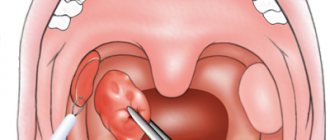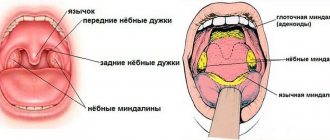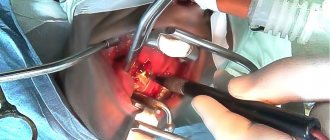A cold is usually accompanied by inflammation of the oropharynx. Therefore, when a person is sick, it is difficult for him to swallow, he has a cough, a sore throat, a runny nose, and a fever. Associated symptoms include discomfort in the muscles and bones, chills, lethargy, and general weakness. The high temperature causes a headache, and swallowing causes severe discomfort in the throat.
If therapeutic measures are not taken in time, the disease will acquire a chronic form, which is characterized by constant and prolonged colds, malaise and weakness.
There are many reasons that can cause a sore throat; in each individual case, only a doctor can prescribe treatment. Make an appointment with an otolaryngologist at the Rossimed clinic to correctly diagnose the disease.
Prices for services
- Consultations
- ENT manipulations
| Services | Price | |||||
| Primary appointment (examination, consultation) with an ENT doctor | 1800 rub. | |||||
| Repeated appointment (examination, consultation) with an ENT doctor | 1500 rub. | |||||
| Appointment (consultation) before washing the tonsils | 1000 rub. | |||||
| Type of manipulation | Price | |||||
| Rinsing the lacunae of the tonsils with the introduction of a medicinal substance | 850 | |||||
| Removal of wax plug 1 side | 700 | |||||
| Rinsing the nasopharynx | 600 | |||||
| Navigating Proetsu ("Cuckoo") | 1 000 | |||||
| Aspiration according to Zonderman | 900 | |||||
| Rinsing the lacunae of the tonsils with the introduction of a medicinal substance | 750 | |||||
| Blowing of the Eustachian tubes according to Politzer | 600 | |||||
| Lubrication of the mucous membrane of the ENT organs, turunda with medicinal substances, insufflation of medicinal powder 1 procedure | 500 | |||||
| Opening a nasal boil | 2 500 | |||||
| Introduction of a medicinal substance into the larynx | 650 | |||||
| Pneumomassage of the eardrum | 500 | |||||
| Stopping nosebleeds with medications | 950 | |||||
| Stopping nosebleeds - anterior tamponade | 1 900 | |||||
| Anemization of the nasal mucosa | 250 | |||||
| Toilet external auditory canal | 650 | |||||
| Removing a foreign body from the pharynx/larynx | 2 250 | |||||
| Removal of a foreign body from the ear, nose | 1 250 | |||||
| Opening a boil of the external auditory canal | 1 900 | |||||
| Puncture of one maxillary sinus | 1 900 | |||||
| Opening of one tonsil cyst | 1 400 | |||||
| Paracentesis of one eardrum | 1 750 | |||||
| Taking a smear from ENT organs | 400 | |||||
| Taking a throat swab for BL (diphtheria bacillus) | 400 | |||||
| Application of medicinal substances into the nasal cavity and ear | 500 | |||||
| Intra-ear compress according to Tsytovich | 600 | |||||
| Non-puncture rinsing of the nasal sinus, 1 side (without the cost of the YAMIK catheter) | 1 900 | |||||
| Intranasal blockade | 900 | |||||
| Catheterization of the auditory tube with anemization and anesthesia | 1 000 | |||||
| Taking histology from ENT organs 1 (one) study, without the cost of histology | 900 | |||||
| OTOSCOPE (without consultation) | 400 | |||||
| RHINOSCOPY (without consultation) | 400 | |||||
| PHARINGOSCOPY (without consultation) | 400 | |||||
| Opening a paratonsillar abscess | 4 900 | |||||
| Parameatal block | 500 | |||||
| Closed reduction of the nasal bones (without the cost of anesthesia) | 7 500 | |||||
| Instrumental sanitation of the nasal cavity | 1 000 | |||||
| Cauterization of the pharyngeal mucosa with drugs | 450 | |||||
| Audiometry | 1 400 | |||||
| Washing the abscess cavity after opening (ENT) | 950 | |||||
| Flushing the maxillary sinus through a catheter | 900 | |||||
| Parameatal block (1 procedure) | 900 | |||||
Make an appointment online
Sign up
Main causes of sore throat
With the onset of cold weather, people increasingly turn to the doctor about colds. During such periods, outbreaks of influenza epidemics are observed. Frequent incidence is observed among people with reduced immunity.
They easily pick up viral and bacterial infections, which are the main cause of discomfort in the throat. Pathogenic microbes enter the mucous membrane of the nasopharynx through airborne droplets or through direct contact with household items, for example, shared dishes, towels, and bed linen.
Patients complain:
- For a sore throat when swallowing.
- Soreness.
- Dry cough.
- Hoarseness of voice.
The cause of such symptoms are toxins produced by bacteria accumulated on the mucous membrane.
However, a sore throat can be caused by vitamin deficiency. In this case, it is necessary to establish proper nutrition. Sometimes it is not possible to restore the deficiency of essential substances through products. In such a situation, the doctor prescribes vitamin complexes.
A sore throat without fever appears as a result of injury to the mucous membrane. However, if an infection penetrates through the damaged areas, then a feverish state will accompany the main symptom.
The cause of discomfort in the larynx can be:
- Dry or air-conditioned air.
- Panic attacks.
- Being in a stuffy room where there is a lot of smoking.
- Injuries caused by sharp objects, such as fish bones.
- Thermal or chemical burns.
In addition, stylohyoid syndrome can cause pain. As well as excessive stress on the vocal cords, for example, when singing or long-term lecturing, in children when screaming and crying.
Features of the course of ARVI without fever
A respiratory viral infection is localized in the nasopharynx and after a couple of days it manifests itself as a certain discomfort. Following tickling and sneezing, copious watery discharge from the nose appears, which after a couple of days becomes mucous, sometimes mixed with blood and pus.
Medical statistics indicate that the main symptom of ARVI, with or without fever, is a runny nose. Four out of ten patients experience a sore or sore throat, and six out of ten subsequently develop a cough, which has certain characteristics associated with a cold.
Dry and superficial, it is rather a reaction to tickling. But with weak immunity, there is a possibility of it spreading to the upper respiratory tract. Having descended into the trachea and further into the bronchi, the infection can finally cause fever. Although recently there have been frequent cases of bronchitis and pneumonia occurring without a significant increase in temperature. Needless to say, when symptoms of ARVI complications appear in children, they should definitely be shown to a good pediatrician?
If the sick person also suffers from muscle pain and aches throughout the body, then his temperature will probably rise greatly, since in this case, influenza will most likely be diagnosed - the most serious of acute respiratory viral infections.
Why does your throat hurt when you don't have a fever?
Hyperthermia is usually present with viral and bacterial infections and colds. The cause is such pathologies as:
- Diphtheria.
- Laryngitis.
- Scarlet fever.
With angina, patients may feel nauseous, loose stools, experience diarrhea, fever, and aching bones and muscles. The reason lies in the general intoxication of the body caused by the accumulation of pus in the retropharyngeal region or an abscess.
Chronic tonsillitis or pharyngitis is not always accompanied by fever.
However, there are cases when patients complain that they have a sore throat for no apparent reason. In such a situation, you should ask what pharmacological drugs have been taken recently. After all, pain can be a side effect of a number of medications.
Some people cannot tolerate tobacco smoke. Even one breath is enough to start coughing and tickling. The reaction to atmospheric pollution by chemical vapors also manifests itself. Therefore, people who work in hazardous industrial conditions, as well as those living in environmentally unfavorable areas, complain that they have a sore throat.
Another reason that causes pain that radiates to the ear is neuralgia of the upper larynx, as well as osteochondrosis of the neck. Similar signs also occur in the presence of neoplasms.
Having considered the various manifestations of sore throat and the causes of its occurrence, it is worth paying attention to the provoking factors. Among which doctors highlight:
- Smoking, including passive smoking.
- Passion for oral sex.
- Decreased protective function. If an adult’s body is able to cope with an infection, then a child with an unformed immune system is easily susceptible to the disease.
- Allergy. Unpleasant sensations in the throat appear mainly in the morning.
In addition, the throat may hurt in patients with HIV and diabetes. The cause is often chemotherapy and hormonal treatment.
Make an appointment online
Sign up
What to do if your throat hurts?
The content of the article:
- Why does your throat hurt and how to treat it?
- How to treat a throat
- Sore throat in children
- Sore throat, what is it: ARVI or Covid
Why does your throat hurt and how to treat it?
Pain, as strange as it may sound, is man's best friend. Thanks to this feeling, we react to some irritating factors and begin to eliminate them in time. A sore throat is also a protective reaction of the body; nerve endings signal that an inflammatory focus has formed or the integrity of the mucous membrane has been compromised.
Painful sensations when swallowing saliva can be different: stabbing, cutting, pulsating, pressing. Pain may vary depending on the time of day, body position, and other factors.
Why a sore throat can hurt and how to quickly cure it will be discussed in this article.
One of the most common causes of sore throat is a viral respiratory disease caused by infection - ARVI. Up to 70% of cases of discomfort in the throat are caused by common colds and flu, when the mucous membrane of the larynx becomes inflamed.
What other diseases can lead to pain:
- tonsillitis - inflammation of the tonsils with enlargement of the submandibular lymph nodes, the patient has a sore throat when swallowing;
- pharyngomycosis - a fungal infection of the mucous membrane, accompanied by a sore throat and pain in the oral cavity;
- gastroesophageal reflux - the reflux of acid from the stomach into the larynx. There is a constant feeling of bitterness in the mouth, it hurts to swallow;
- an allergic reaction, accompanied by severe swelling of the mucous membrane and difficulty swallowing;
- pharyngitis - inflammation of the tissues of the pharynx. The disease often begins due to a runny nose.
- peritonsillar abscess - a complication due to tonsillitis or pharyngitis;
- Laryngitis is inflammation of the laryngeal mucosa. Laryngitis is characterized by a sore throat and cough.
In fact, the main causes of all these diseases are:
- viruses;
- bacteria;
- fungi;
- allergens.
Most often, the causative agent is a virus that is transmitted by airborne droplets or contact.
Interesting on the topic: Sore throat - causes and methods of treatment
How to treat a throat
To begin with, you should always conduct a diagnosis and determine why your throat hurts so much. To do this, you need to consult a doctor. Self-diagnosis and treatment can make the situation worse, because each pathology requires certain medications.
For diagnosis you may need:
- visual examination of the throat mucosa;
- throat swab;
- general and biochemical blood test;
- Analysis of urine.
Based on the results of the identified disease, the doctor determines treatment tactics and may prescribe the following medications:
- antibiotics;
- antifungal agents;
- antiviral;
- antibacterial sprays, tablets;
- antihistamines;
- immunostimulants;
- painkillers;
- non-steroidal anti-inflammatory drugs.
Each pathology requires its own approach to treatment and a set of drugs. In what cases should these medications be used:
- Antibiotics are prescribed only in cases where the disease is caused by exposure to pathogens, or a secondary bacterial infection has occurred. Most often they are used for sore throats and tonsillitis, which are caused by streptococci and staphylococci.
In the case of a viral or fungal infection of the throat mucosa, antibiotics are not only useless, but also harmful because they will kill beneficial bacteria and weaken the body.
- Antimycotic drugs are used in case of fungal infection of the oropharyngeal mucosa. The diagnosis of “oral thrush” is made only after a laboratory examination of a smear taken for analysis, but visually it is difficult to confuse oral fungus with something else. A characteristic cheesy coating appears on the mucous membrane. To treat fungus, systemic tablets and local antibacterial sprays are used.
- Antihistamines are used if a sore throat when swallowing is caused by swelling of the mucous membrane. The cause may be an allergic reaction or a viral disease. In both cases, the person experiences unpleasant sensations. Antihistamines do not work against bacteria and viruses, but they significantly alleviate the disease.
- Tablets and lozenges with antiseptic and antimicrobial effects will help if your throat hurts and it hurts to swallow. They eliminate discomfort temporarily and also suppress the proliferation of bacteria and microbes in the oropharynx. Some drugs have a mild local anesthetic effect.
- Antibacterial sprays also suppress the development of pathogenic microflora in the throat and have an anesthetic property.
- NSAIDs are used to relieve inflammation in the throat and also to relieve pain.
You can relieve a sore throat by gargling. For these purposes, use saline, soda solutions, rinses with Miramistin or any other antiseptics diluted in water in the required proportion. Pharmacies also sell medicinal herbs that have antiseptic properties.
Physiotherapy treatment is also effective in relieving sore throat. If there are no contraindications, then the following procedures can be used:
- ultraviolet irradiation;
- phonophoresis - the effect of ultrasonic high-frequency waves on foci of inflammation with the simultaneous use of medications;
- magnetic therapy;
- laser irradiation - exposure to the source of inflammation - with a monochrome beam of light;
During the period of illness, you should also limit the consumption of salty, sour, and spicy foods, so as not to injure the mucous membrane even more. Cold and very hot drinks and food are also excluded.
If your throat hurts often, then this is a reason to consult an immunologist and get tested for a lack of vitamins and microelements. It happens that the body cannot cope with its protective functions, and any hypothermia can cause a breakdown in the immune system and a lingering cold with a severe sore throat.
Sore throat in children
Children are more susceptible to various viral and respiratory diseases because, due to their age, they are more likely to become hypothermic, are constantly in crowded places and are less concerned about hygiene and social distance.
Therefore, a large percentage of throat diseases occur specifically in them.
After the pediatrician diagnoses the child’s type of disease: ARVI, acute respiratory infections, influenza, etc. he writes out a list of necessary medications.
Treatment of adults and children is not much different. Only the dosages of drugs and the form of their release differ. The rest of the treatment mechanism is aimed in the same way at
- relief of pain;
- eliminating inflammation in the throat;
- relieving swelling.
By the way, everyone’s favorite alcohol compresses on the throat today are no longer considered such effective and desirable methods of treatment. Today there are a lot of devices for physiotherapy, and medications for sore throats cope with this task much better.
Sore throat, what is it: ARVI or Covid
Against the backdrop of the ongoing global pandemic, it is important to distinguish between the symptoms of ARVI and Covid in order to apply the correct treatment tactics.
In both cases, similar symptoms are observed:
- body aches;
- acute sore throat;
- temperature;
- fatigue;
- runny nose;
- cough.
However, you need to know that ARVI develops quickly. It only takes a few days from infection to the onset of symptoms. Covid goes through an incubation period of 12-14 days.
With ARVI, the temperature gradually rises to 38-39 degrees, causing a febrile state. With Covid, the temperature constantly stays at 37.0-37.5.
The general treatment tactics for these diseases vary, but local remedies remain the same. If you have a severe sore throat, you can use the same antibacterial sprays and lozenges with an analgesic and antimicrobial effect for relief. You can take antihistamines to relieve swelling of the mucous membrane.
A sore throat usually goes away quickly, unless, of course, it is a protracted sore throat in its follicular or lacunar form. You will have to wait 1-3 days until the natural physiological processes accompanying the disease pass: swelling of the mucous membrane, its inflammation and possibly even the formation of a purulent or cheesy coating on the mucous membrane.
With the help of medications selected by a doctor, you can stop the processes that have begun, prevent them from moving into the acute phase and quickly cure your throat.
Associated symptoms
Each pathology is characterized by a certain set of symptoms. So, with a cold and acute respiratory infections, in addition to fever and sore throat, a runny nose and cough, nasal congestion and difficulty breathing can be observed.
Associated symptoms of ARVI and influenza are:
- General weakness.
- Muscle, joint and headaches.
- Hyperthermia.
When infected with viruses, a rash on the skin, enlargement of the spleen and lymph nodes in the neck and armpits may occur.
What could a cough be like?
Its appearance plays an important role in diagnosing cough and combating it. You can also cough in different ways, which reduces the list of possible causes in a particular case and determines the features of further treatment of the disease.
In this regard, we may encounter a cough:
- dry (sometimes with wheezing) and wet (accompanied by sputum production). Dry is more characteristic of allergic manifestations, reactions to dust, smoke, dry air, it accompanies heart disease, and wet - colds, bronchitis, tuberculosis and similar diseases;
- paroxysmal (a person suffocates and feels severe discomfort in the throat). This cough is most often encountered with asthma, smoking, and chronic diseases of the respiratory system. It often changes from dry to wet;
- long-term, which does not go away within a month or longer - asthma, whooping cough, chronic bronchitis, smoking, enlarged thyroid gland;
- deep, which is a sign of allergies and respiratory diseases, tumors;
- rare and short-term, which most often shows the impact of provoking factors at a given moment in time - high/low humidity, fungus, the presence of an allergen, toxins in the air;
- purulent, indicating a severe bacterial infection;
- with a sore throat, when coughing itself also causes pain.
This means that the pain receptors of the mucous membrane are irritated (sore throat, pharyngitis, laryngitis) or the mucous membrane itself is damaged.
Pay attention to what kind of cough you have, try to determine what it looks like. The doctor will definitely ask about this during the appointment, especially if during the entire time you were in his office you never coughed. This classification, together with other symptoms and diagnostics, allows an accurate diagnosis to be made.
Diagnosis of diseases
The choice of treatment tactics depends on the type of pathology. Therefore, it is necessary to carefully examine the patient. Diagnosis begins with collecting anamnesis. The doctor asks questions that help determine the symptoms characteristic of a particular disease. He is interested:
- The timing of the appearance of the first signs of illness.
- The time when the severity of symptoms increases. This could be at night or in the morning.
- Which side of the throat is the pain more intense - the right or the left? This is usually how acute pharyngitis manifests itself.
- The presence of hoarseness and changes in voice may indicate sore throat or laryngitis.
If only the right or left side hurts, then the presence of neoplasms can be suspected. In babies, the cause may be teething.
Differential diagnosis is necessary to identify pathologies such as Hilger's syndrome, gastroesophageal reflex, dysfunction of the thyroid gland and adrenal glands, cervical osteochondrosis, esophageal varicose veins.
Often a sore throat appears during myocardial infarction.
The second stage of diagnosis involves examining the patient. The doctor assesses the condition of the mucous membranes of the nose and mouth. It can detect plaque, swelling, redness, signs of injury, and neoplasms.
If an infection is suspected, a swab is taken and sent for testing to a laboratory.
A clinical blood test can reveal the inflammatory process.
If there are complaints of pain radiating to the ear, otoscopy is prescribed.
Treatment options
To effectively treat dryness, sore throat and cough, it is necessary first of all to act on the cause of their occurrence - inflammation. To make an accurate diagnosis, you should consult a doctor who, depending on the anamnesis (history of the development of the disease), complaints and examination, will immediately suggest a particular disease or prescribe additional examinations and consultations. Since dryness, tickling and cough are not a diagnosis, but only one of the symptoms of the disease, it is necessary to carry out comprehensive treatment, and not limit ourselves to just eliminating unpleasant symptoms. Elimination of pathogens.
In case of infectious origin of tickling and cough, therapy is prescribed that acts on the pathogen - antiviral, antibacterial or antifungal drugs for systemic use (orally or by injection, in the form of rectal suppositories).
The selection of an antibiotic or antiviral agent is carried out by a doctor. Under no circumstances should you independently cancel and replace one drug with another or stop taking it earlier - this can lead to the progression of the process or its transition to a chronic stage. Pain relief
. However, cough and severe sore throat, as a rule, are subjectively difficult for patients to tolerate, causing severe discomfort and disrupting their usual way of life. Therefore, it is difficult to do without the use of symptomatic medications to reduce the severity of complaints. For this purpose, a variety of local remedies are used: tablets and lozenges, sprays, rinsing solutions. If your throat is very sore, frequent warm drinks, warming and distracting procedures can help soothe the irritation of the mucous membranes. If you have a painful, obsessive, prolonged non-productive cough, you may need to prescribe antitussive drugs.
When to see a doctor
In addition, qualified medical assistance will be required:
- When there are no signs of a cold, but the pain is intense and does not go away for two days.
- The temperature rises sharply and reaches critical levels.
- Purulent formations are visible on the mucous membranes of the throat.
- If the changed voice is not restored within 2 weeks.
An ambulance will be called if the intensity of the pain does not allow you to swallow saliva or the swelling of the mucous membranes is severe, which causes difficulty breathing, in which extraneous noises in the form of whistling and wheezing are heard.








